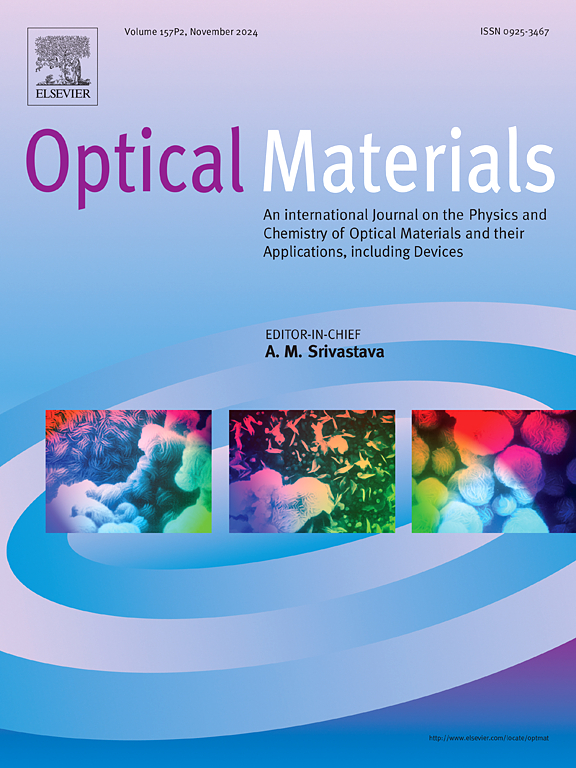绿色水热合成金/TiO2纳米复合材料的研究(英文
IF 3.8
3区 材料科学
Q2 MATERIALS SCIENCE, MULTIDISCIPLINARY
引用次数: 0
摘要
在这项研究中,我们描述了一种环境友好和可持续的方法来合成TiO2 NPs和Au/TiO2纳米复合材料(Au/TiO2 NPs),利用茄子皮提取物(Solanum melongena L.)作为生物模板和络合剂来增强光催化氢(H2)的生成。利用场发射扫描电子显微镜(FE-SEM)和透射电子显微镜(TEM)对TiO2 NPs和Au/TiO2 NPs的纳米结构进行了表征,透射电子显微镜(TEM)图像显示出不同形状的TiO2 NPs,而Au/TiO2 NPs表面均匀分布着细小的Au颗粒。x射线衍射(XRD)证实了锐钛矿和金红石的结构,Au/TiO2 NPs的峰与AuNPs的面心立方(fcc)结构相对应。紫外-可见(UV-Vis)吸收光谱表明,Au/TiO2 NPs的吸收峰发生了红移,当Au/TiO2 NPs掺入后,TiO2 NPs的带隙能从3.06 eV降至2.95 eV,这是光催化应用的关键因素。基于电化学H2演化,在可见光下,Au/TiO2 NPs在182 mV下的过电位显著降低,Tafel斜率为129 mV/dec。系统研究了以甲醇为牺牲电子供体的TiO2 NPs和Au/TiO2 NPs在可见光优化条件下的产氢性能,包括反应时间、浓度、催化剂用量、pH和温度。经过6次循环后,Au/TiO2 NPs的光催化制氢速率为468.3 μmol,在420 nm处的表观量子产率(AQY)达到9.3%。结果表明,Au/TiO2 NPs催化剂在解决与环境问题和能源问题相关的即将到来的挑战方面具有很大的潜力。本文章由计算机程序翻译,如有差异,请以英文原文为准。
Green hydrothermal synthesis of Au/TiO2 nanocomposites using eggplant (Solanum melongena L.) peel extract for enhanced photocatalytic hydrogen production
In this study, we described an environmentally friendly and sustainable approach for the synthesis of TiO2 NPs and Au/TiO2 (Au/TiO2 NPs) nanocomposites utilizing eggplant peel extract (Solanum melongena L.) as a bio-template and complexing agent for enhanced photocatalytic hydrogen (H2) production. The nanostructures of the TiO2 NPs and Au/TiO2 NPs were examined using Field emission-Scanning electron microscopes (FE-SEM) with Energy dispersive spectroscopy (EDS) mapping and Transmission electron microscopes (TEM) images displayed diverse spherical shapes of TiO2 NPs, while Au/TiO2 NPs exhibited fine Au particles uniformly distributed on the TiO2 NPs surface. X-ray diffraction (XRD) pattern confirmed anatase and rutile structures, with Au/TiO2 NPs exhibiting peaks corresponding to face-centered cubic (fcc) structure of AuNPs. UV–Visible (UV–Vis) absorption spectra indicated a redshift in absorption peaks for Au/TiO2 NPs and the bandgap energy of TiO2 NPs was initially measured at 3.06 eV upon incorporation of Au (Au/TiO2 NPs) decreased to 2.95 eV, a crucial factor for potential photocatalytic applications. Based on the electrochemical H2 evolution, Au/TiO2 NPs demonstrated significantly reduced overpotentials measuring at 182 mV along with a Tafel slope of 129 mV/dec under visible light. The photocatalytic H2 production of TiO2 NPs and Au/TiO2 NPs with methanol as a sacrificial electron donor under visible light optimization including reaction time, concentration, catalyst dosage, pH, and temperature were systematically studied. The Au/TiO2 NPs exhibited a photocatalytic H2 production rate of 468.3 μmol after 6 cycles with an apparent quantum yield (AQY) reaching 9.3 % was achieved at 420 nm. The results suggest a promising potential for the Au/TiO2 NPs catalyst in addressing forthcoming challenges associated with both environmental issues and energy concerns.
求助全文
通过发布文献求助,成功后即可免费获取论文全文。
去求助
来源期刊

Optical Materials
工程技术-材料科学:综合
CiteScore
6.60
自引率
12.80%
发文量
1265
审稿时长
38 days
期刊介绍:
Optical Materials has an open access mirror journal Optical Materials: X, sharing the same aims and scope, editorial team, submission system and rigorous peer review.
The purpose of Optical Materials is to provide a means of communication and technology transfer between researchers who are interested in materials for potential device applications. The journal publishes original papers and review articles on the design, synthesis, characterisation and applications of optical materials.
OPTICAL MATERIALS focuses on:
• Optical Properties of Material Systems;
• The Materials Aspects of Optical Phenomena;
• The Materials Aspects of Devices and Applications.
Authors can submit separate research elements describing their data to Data in Brief and methods to Methods X.
 求助内容:
求助内容: 应助结果提醒方式:
应助结果提醒方式:


